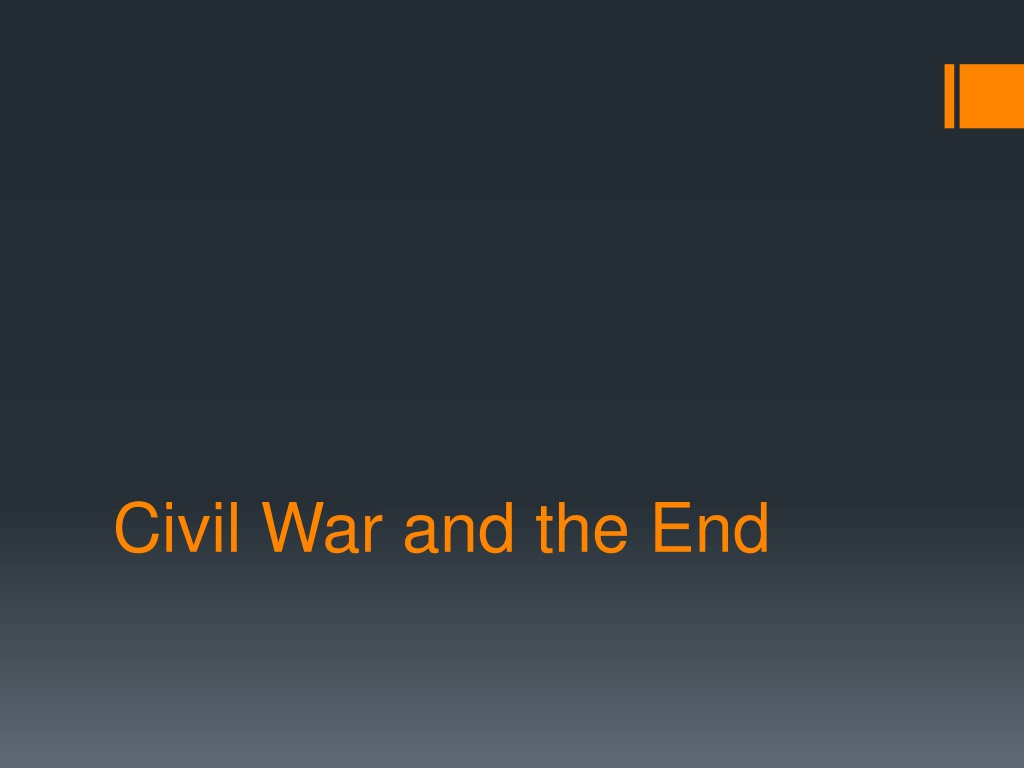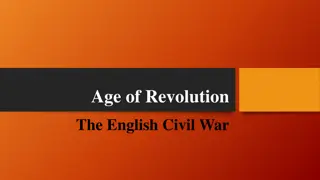Major Battles and End of the Civil War Timeline
The timeline covers significant events during the American Civil War, including the Battle of Shiloh, Second Battle of Bull Run, Battle of Antietam, Gettysburg, and the Gettysburg Address. The battles were consequential, resulting in high casualties and strategic shifts in the war. The Gettysburg Address highlighted the dedication to equality and the preservation of the Union, marking a pivotal moment in American history.
Download Presentation

Please find below an Image/Link to download the presentation.
The content on the website is provided AS IS for your information and personal use only. It may not be sold, licensed, or shared on other websites without obtaining consent from the author. Download presentation by click this link. If you encounter any issues during the download, it is possible that the publisher has removed the file from their server.
E N D
Presentation Transcript
Battle of Shiloh April 6/7, 1862; massive battles in Shiloh, Tennessee. South attacks North before reinforcement arrive. Shocking the nation, 20,000 soldiers combined die. North wins and is in great position to take full control of Mississippi River
Second Battle of Bull Run (Manassas) Aug 29, 1862- Confederate and Union troops meet again. Jackson s and Lee s forces meet up and defeated the Union army. Instead of being close to take Richmond as Lincoln wanted, Southern troops were now only 20 miles from Washington D.C.
Battle of Antietam North found a copy of Lee s orders and knew what Lee was going to do. Battle started on Sept. 17. Single most bloody day of Civil War, 30,000 men die. South retreated Importance: Army of Potomac(puh-toe-mic) (North) gain some confidence. Marked change in War aim, now concentrating on ending slavery.
Gettysburg July 1-3, 1863; General Lee tried to invade the North and Union battled outside the town of Gettysburg, PA. Union won, but both sides lost a lot of men: Confederates 28,000 & Union 23,000 Led to the Gettysburg Address
Gettysburg Address Lincoln addressed those gathered at Gettysburg to dedicate the land as a cemetery Significant development in the history of individual rights. Promises that the union will eventually join together and give people equality! Government of the people, by the people, and for the people
The Address Four score and seven years ago our fathers brought forth, upon this continent, a new nation, conceived in liberty, and dedicated to the proposition that "all men are created equal" Now we are engaged in a great civil war, testing whether that nation, or any nation so conceived, and so dedicated, can long endure. We are met on a great battle field of that war. We have come to dedicate a portion of it, as a final resting place for those who died here, that the nation might live. This we may, in all propriety do. But, in a larger sense, we can not dedicate -- we can not consecrate -- we can not hallow, this ground-- The brave men, living and dead, who struggled here, have hallowed it, far above our poor power to add or detract. The world will little note, nor long remember what we say here; while it can never forget what they did here. It is rather for us, the living, to stand here, we here be dedica-ted to the great task remaining before us -- that, from these honored dead we take increased devotion to that cause for which they here, gave the last full measure of devotion -- that we here highly resolve these dead shall not have died in vain; that the nation, shall have a new birth of freedom, and that government of the people by the people for the people, shall not perish from the earth.
Emancipation Proclamation January 1863 North wants to change goal of war and prevent France and England from helping the South. Lincoln issues Emancipation Proclamation. It freed all slaves in rebellion against the Union. Border States were allowed to keep slaves.
Effects of the Emancipation Proclamation Emancipation Proclamation was more symbolic. Didn t really free anyone. It did give African Americans and abolitionists reason to celebrate. It caused Britain and France to withhold recognition of the Confederacy. Gave new cause to War. In 1864 Republicans in Congress prepared the 13thAmendment abolishing Slavery. It was ratified in 1865. Led to the use of African American troops in the Civil War.
Final Phases of War Gen. Ulysses S. Grant and Gen. William Tecumseh Sherman Won battles in Chattanooga, TN. Lincoln makes Grant head of Union Army (1864) Grant would fight Lee in Virginia. Sherman fights to take Atlanta, GA Series of 3 battles: Battle of Wilderness, Spotsylvania, Cold Harbor.
Shermans March to the Sea Sherman began a march to the Sea to Savannah, Georgia. He abandons supply lines and has armies eat off the line, using anything it could and killing or destroying anything left. This was called Total War. After arriving in Georgia, Sherman headed to South Carolina. He called it Total War 360px-Sherman_sea_1868
Victory in the North File:The Fall of Richmond Virginia on the Night of April 2nd 1865.jpeg Lincoln spoke of healing between North and South in 2ndInaugural Speech. Meanwhile Grant was still trying t gain control of Petersburg. On April 2, 1865 Petersburg fell, and Richmond fell on the same day.
Surrender at Appomattox Lee tried to moved west of Richmond to meet up with small confederate forces but was blocked. On April 9, 1865 Lee surrenders his troops to Grant at Appomattox Court house in Virginia. Several days later confederate forces in South Carolina surrender to Sherman. Jefferson Davis was captured on May 10, 1865.
Flag Fad and Dixiecrats The United Confederate Veterans (UCV) work from 1870s to 1948 to protect the meaning and importance of the confederate flag In 1948 the Dixiecrat party was an off shoot of the Democratic Party The Dixiecrats disagreed with the parties decision to adopt Civil Rights to their platform They used the Confederate battle flag to protest Civil Rights and in support of Jim Crow segregation laws This was called the flag fad
The flags meaning Confederate Heritage organizations tried to separate the flag from this new meaning and preserve the dignity They wanted it to retain its meaning to memorialize the fallen soldiers but it became confetti in careless hands This attempt to protect the flag, over time turned into protecting the right to wear it and display it in the exact way that had been considered desecration


![❤[PDF]⚡ Civil War Talks: Further Reminiscences of George S. Bernard and His Fel](/thumb/20551/pdf-civil-war-talks-further-reminiscences-of-george-s-bernard-and-his-fel.jpg)




















